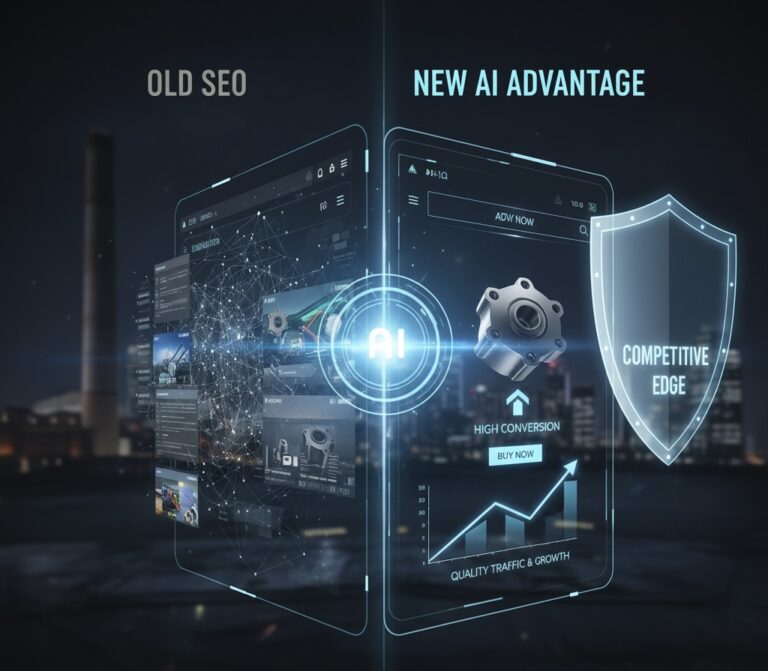AI is changing how buyers discover products
- Marco Flapper | 14-10-2025
Digital Trends for 2026
How AI, data, and automation are changing B2B e-commerce forever
The world of B2B e-commerce is changing faster than ever. Whereas a few years ago we were mainly talking about omnichannel and personalization, we are now talking about autonomous purchases, AI co-pilots, and data as a revenue model.
Intershop’s Digital Trends Report 2026 shows that companies experimenting with AI today will lead the market tomorrow. Not by doing more, but by working smarter. By seeing technology not as an end in itself, but as an accelerator of value, for both customers and organizations.
In this blog series, I will take you through the six most important trends that will determine success in B2B commerce in the coming years. From AI taking over the purchasing process to managers reinventing their roles.
Each article provides insights, concrete examples, and practical steps to get started yourself.
Whether you’re working on growth, efficiency, or customer focus, these trends will help you move forward.
And believe me: the future of e-commerce is not something that is going to happen. It is something that is already happening today.

Trend 1: AI is changing how buyers discover products
The way customers find products online is changing radically. Where search engines like Google have determined traffic for years, we are now seeing the rise of AI tools such as ChatGPT, Gemini, and Copilot. These “answer engines” provide immediate answers to questions, rather than just showing links to websites. And that has major consequences for your visibility as a brand or online store.
According to Semrush, traffic via traditional search engines will decline by 25% before 2026. At the same time, the share of visitors coming in via AI systems is increasing, and these are often buyers with a higher conversion rate. Gartner confirms this: AI search traffic converts 4.4 times better than traditional organic traffic. In concrete terms, this means that AI visitors buy more often, an opportunity you don’t want to miss.
From SEO to AEO and GEO
You hear it more and more often: “SEO is dead.” That’s a bit of an oversimplification. SEO is changing. Where it used to be all about keywords, it’s now about context, structure, and findability in AI systems.
Two new forms of optimization are emerging: – AEO – Answer Engine Optimization: optimizing tools that provide direct answers instead of search results. – GEO – Generative Engine Optimization: ensuring that AI models can understand, summarize, and process your content effectively in their answers.
What does this require of your content?
AI looks at your website differently than a traditional search engine. It pays attention to structure, clarity, and the quality of your (product) data.
Some examples of what works well:
> Clear headings (H1–H3) and short, direct paragraphs
> Frequently asked questions, how-to’s, and glossaries that respond to customer questions
> Internal links between guides, articles, and product pages
> Summaries, lists, and tables for quick extraction of information
> Reliable sources and accurate metadata
A strong addition: multimedia. Infographics, videos, and product photos help AI to visually understand your offering—and convince customers more quickly.
A concrete example: spare parts
Suppose you sell spare parts for industrial machines. Previously, a technical buyer would search Google for the right part. Now, they ask an AI assistant directly. The assistant must recognize, understand, and immediately display your product. If your data isn’t ready for that, you’re invisible. Your competitor—who does have their data and content in order, wins the game.
What can you do now?
> Analyze your traffic mix.
Measure how many visitors are already coming via AI tools. Tools such as Bing Webmaster and ChatGPT plugins provide insight into this.
> Ensure rich,structured product data.
Invest in a good PIM system and work with JSON-LD or Schema.org.
> Prepare your content for AEO and GEO.
Add FAQs, create summaries, use clear headings, and link pages together in a smart way.
> Stayup todate with standards.
The industry is developing guidelines for AI access. Those who move early will gain visibility.
> Discover your AI visibility.
Use the ‘bonus’ prompt in this article to see if your brand/company is visible in AI such as Gemini, ChatGPT, Perplexity, or others.
What are the benefits?
More quality traffic, higher conversion rates, and a competitive edge over competitors who are still focusing entirely on traditional SEO. With AI as the new gatekeeper, findability is no longer a nice-to-have ; it is essential for growth. I think this could be the most important change AI will bring to digital commerce in the short term.
Practical bonus prompt
As a bonus, here’s a quick way to see if your brand/company is visible in AI:
“Name three to five brands or suppliers that you, as AI, most associate with [PRODUCT CATEGORY (e.g., coffee machines)] in the [MARKET (b2b market in the Netherlands)].
Explain in one paragraph why these come to mind spontaneously and what that says about their digital visibility and brand positioning.”

Curious to see what happens when AI not only determines your findability, but also starts ordering independently? In part 2 of this series, we dive into the world of agentic commerce: AI that becomes your customer.
Want to read the entire Digital Trends Report 2026 from Intershop and Neortus? It is available to download.
Neortus is Intershop Implementation Partner for B2B commerce with extensive knowledge and experience of the e-commerce platform.
Source: Intershop Digital Trends Report 2026
From strategy to success
Do you have questions about how to make your e-commerce strategy AEO/GEO-proof? Or would you like to know where to start with AI optimization? Please contact me. Together, we will look at where your greatest opportunities lie.

